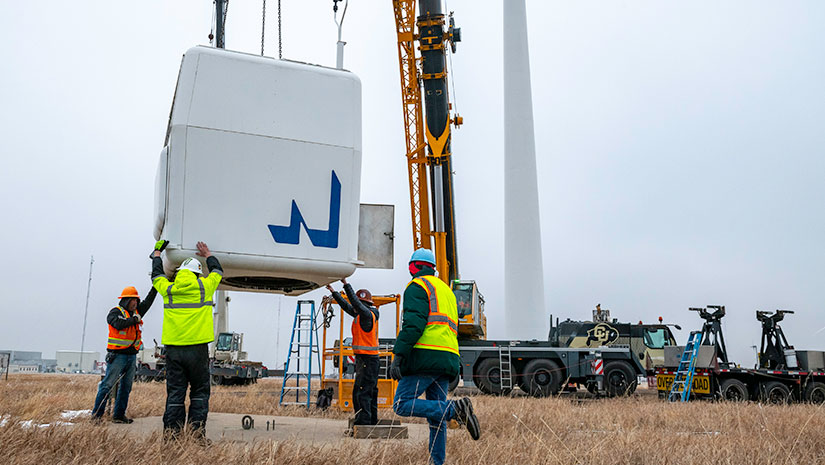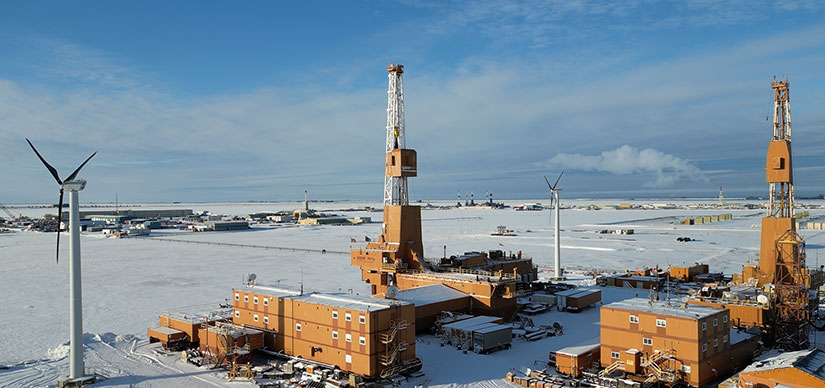Saying Goodbye to a Cold-Weather Workhorse
Wind Turbine’s Removal Sets New NREL Distributed Wind Research Capabilities in Motion
This video contains no spoken audio. Watch this timelapse of the NorthWind 100 Wind Turbine being taken down at NREL’s Flatirons Campus.
The National Renewable Energy Laboratory (NREL) recently bid farewell to a 100-kilowatt (kW) distributed wind turbine prototype on NREL’s Flatirons Campus. The turbine’s removal signals the beginning of new, expanded distributed wind research capabilities for the laboratory.
After arriving at NREL in February 2001, the Northern Power Systems’ NorthWind 100 wind turbine was used for a variety of wind energy research projects such as early hybrid wind/diesel systems for deployment in Alaska. In cooperation with NASA and the U.S. Department of Energy (DOE), Northern Power Systems developed the NorthWind 100 to demonstrate extreme cold-weather operation in Vermont, Colorado, Alaska, the South Pole, and eventually a futuristic application on Mars.
“The NorthWind was the first real cold-weather turbine. Because it would be potentially too dangerous and too cold to work on the outside of a turbine in harsh environments, people could climb up and work inside its box-shaped nacelle,” said NREL Power Systems engineer Dave Corbus, who worked as an engineer on the turbine during the first three years it was at NREL. “No other small turbine had a nacelle that you could work inside of.”

Other NREL research measured loads on the blades and on the shaft, which NREL researchers compared to design standards.
“Some of the first power quality measurements that we developed for IEC test standards were done on that turbine,” Corbus said. In February 2004, the NorthWind 100 became the first wind turbine to receive a design conformity statement from Underwriters Laboratories to the International Electrotechnical Commission (IEC) 61400-1 standard.
This research helped Northern Power Systems mature the NorthWind 100’s control procedures, technical capabilities, and engineering efficiency. The Cold Weather Turbine Project, which DOE’s Wind Energy Technologies Office funded through NREL and Northern Power Systems completed in 2004, used the NorthWind 100 turbine to study extreme cold operation. The turbine was subsequently refined and taken to production to serve remote locations in cold regions around the world.
"The Cold Weather Turbine Project helped to demonstrate the viability of wind energy in extreme and remote applications and was vital to the development of our now well-proven wind turbine platform,” said Chris Connor, Northern Power Systems principal engineer. “Even today—20 years and nearly 900 wind turbines later—this turbine still utilizes the same direct-drive, stall-regulated architecture to provide reliable wind power in environments from the Arctic to the Caribbean."
Parts Will Support Wind Turbines in Alaska
Despite its age, the old workhorse is not being put completely out to pasture. Some of its parts will support existing installations in Alaska. Northern Power Systems continues to offer cold-weather “Arctic” turbines and recently installed two new NPS 100C-24 Arctic wind turbines (modern versions of the NorthWind 100) in Prudhoe Bay, Alaska, at a remote oil drilling facility.
According to Northern Power Systems, these are the first wind turbines on Alaska's North Slope and are among the world’s northernmost wind turbines. The NPS 100 Arctic model can operate in the harshest cold-weather conditions in temperatures as low as −40°C.

Replacement Turbine To Usher In a New Research Era
Where the NorthWind 100 turbine once stood, NREL will install and commission a new distributed wind turbine in early 2024. That turbine, rated at 90 kW and manufactured by Eocycle, will be one of three modern distributed wind turbines that will form a new distributed wind research facility on the Flatirons Campus.
“The U.S. Department of Energy’s Wind Energy Technologies Office is expanding research and development around distributed wind technology,” said NREL distributed wind lead Ian Baring-Gould. “The three modern turbines on Flatirons Campus will provide an exciting new capability that will support further deployment of distributed-scale wind turbines across the United States.”
The three new research turbines will eventually be connected to the new Flatirons Campus Distributed Integrated Energy Laboratory, which will enable NREL researchers to study how the turbines interact with the power grid.
Distributed wind turbines can generate, store, and manage energy consumption for nearby customers while increasing power system reliability and resilience. According to DOE’s Distributed Wind Market Report: 2023 Edition, 90% of distributed wind projects deployed in 2022 provided energy for on-site use, and 10% of projects were interconnected to a distribution grid to provide energy for local use.
Stay tuned for news about the NREL’s distributed wind research capability, and learn more about NREL's wind energy research facilities. Please be sure to subscribe to NREL's wind energy newsletter for more news like this.
Last Updated May 28, 2025
